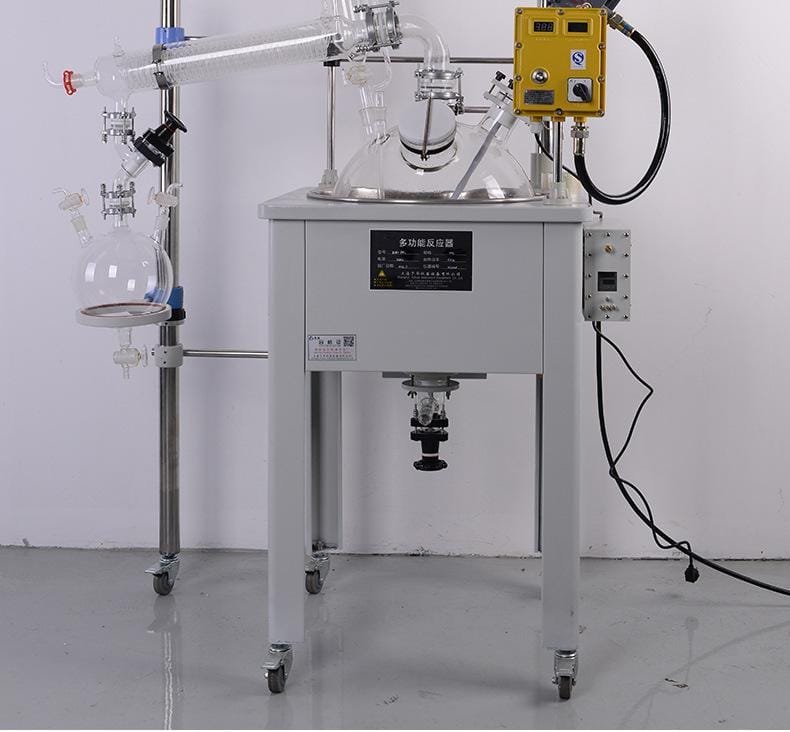The Single Glass Reactor Design is a fundamental tool in many chemical laboratories, known for its versatility and efficiency. Used in a wide range of applications, including synthesis, distillation, extraction, and crystallization, this reactor type has become a go-to choice for researchers and industrial professionals. The ability to precisely control reaction conditions such as temperature, pressure, and stirring speed makes it an indispensable component in experimental setups. This article will explore the key advantages of Single Glass Reactor Design, its common applications, and why it remains a top choice in laboratory equipment.

What Is the Single Glass Reactor Design?
At its core, the Single Glass Reactor Design is a piece of laboratory equipment made from high-quality borosilicate glass, designed to perform chemical reactions under controlled conditions. Its transparent construction allows researchers to observe the reaction in real-time, offering valuable insights into the progress of the experiment. A typical Single Glass Reactor Design is equipped with a variety of components including a condenser, thermometer, heating jacket, and stirrer. These features help regulate the reaction environment and ensure that the process proceeds under optimal conditions.
One of the significant advantages of the Single Glass Reactor Design is its ability to handle a variety of chemical reactions. Whether you are conducting simple distillation or complex synthesis processes, this reactor can meet the demands of both small-scale research and large-scale industrial applications.
Key Features of the Single Glass Reactor Design
- High-Quality Borosilicate Glass Construction: The Single Glass Reactor Design is constructed from borosilicate glass, which is renowned for its durability and resistance to thermal shock and chemical corrosion. This material is ideal for laboratory environments where the equipment is exposed to high temperatures and reactive chemicals. The clarity of the glass also allows for continuous monitoring of the reaction, providing immediate feedback on the experiment’s progress.
- Versatility Across Multiple Applications: The Single Glass Reactor Design is highly versatile, capable of supporting various laboratory processes. Common uses include chemical synthesis, distillation, extraction, and crystallization. Its adaptability makes it a preferred choice in laboratories involved in pharmaceutical, chemical, and environmental research. With the ability to handle both organic and inorganic reactions, the Single Glass Reactor Design is indispensable in many research settings.
- Precision Control of Reaction Conditions: One of the standout features of the Single Glass Reactor Design is the ability to control key reaction parameters. This includes temperature regulation via a heating jacket, pressure control through a vacuum system, and stirring speed to ensure proper mixing of reactants. These controls enable researchers to optimize reaction conditions, improving yields and ensuring the reproducibility of results.
- Safety Features for Safe Operation: The Single Glass Reactor Design comes with several built-in safety features that ensure secure operation. These include pressure release valves, locking mechanisms, and temperature control systems to prevent overheating or unwanted reactions. These safety features are crucial when working with volatile or hazardous chemicals, ensuring the well-being of laboratory personnel.
- Compact and User-Friendly Design: The Single Glass Reactor Design is designed to be compact, allowing for easy integration into laboratory spaces with limited room. Additionally, its user-friendly interface makes it suitable for both novice and experienced researchers. Many models feature intuitive control panels, making the operation of the reactor straightforward and efficient.
Applications of Single Glass Reactor Design in Chemical Processes
- Chemical Synthesis: The Single Glass Reactor Design is widely used in chemical synthesis, where precise control over temperature, pressure, and mixing is crucial. Researchers rely on the reactor for processes such as polymerization, hydrolysis, and esterification. By maintaining a stable reaction environment, the reactor ensures high yields and purity of the desired product.
- Distillation: Distillation is one of the most common applications for the Single Glass Reactor Design. Its ability to maintain a controlled temperature and pressure environment makes it perfect for separating components of a mixture based on their boiling points. This is particularly useful in industries such as pharmaceuticals, where the purity of products is essential.
- Extraction: In the field of biotechnology and natural product chemistry, the Single Glass Reactor Design is often used for the extraction of bioactive compounds from plants or other organic materials. The ability to conduct extractions under vacuum or with temperature control allows for better yields and preserves the integrity of the extracted compounds.
- Crystallization: The reactor’s precise control over temperature and pressure also makes it ideal for crystallization processes, where the goal is to form solid crystals from a solution. This is commonly used in the production of high-purity substances in pharmaceutical and chemical industries.
Why Choose the Single Glass Reactor Design from EquilRxnLab?
When choosing laboratory equipment, quality and reliability are key factors. EquilRxnLab offers a range of products, including the AKDF-30L Single-Layer Glass Laboratory Distillation Reactor, which is specifically designed to handle a variety of chemical processes. This product is a prime example of how a Single Glass Reactor Design can enhance laboratory efficiency. With its durable construction, precise control features, and easy integration into laboratory setups, it’s an excellent choice for researchers looking to optimize their chemical processes.
Learn more about the Single Glass Reactor Design and its advanced features by visiting the product page. To keep up with the latest innovations in laboratory equipment, follow EquilRxnLab on YouTube, Instagram, and Facebook.
Conclusion
The Single Glass Reactor Design plays a vital role in a wide array of laboratory processes. Whether for chemical synthesis, distillation, or extraction, the reactor’s ability to maintain precise environmental conditions is key to improving the efficiency and reproducibility of experiments. Its durability, safety features, and ease of use make it a reliable tool for both research and industrial applications.
For more information on how the Single Glass Reactor Design can enhance your laboratory operations, visit EquilRxnLab or explore our product catalog here.



